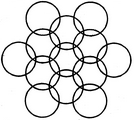Discussion
Home ‣ Non Verbal Reasoning ‣ Series See What Others Are Saying!
- Question
Select a figure from amongst the Answer Figures which will continue the same series as established by the five Problem Figures.
Problem Figures: Answer Figures: (A) (B) (C) (D) (E) (1) (2) (3) (4) (5)
(A) (B) (C) (D) (E) (1) (2) (3) (4) (5)
Options- A. 1
- B. 2
- C. 3
- D. 4
- E. 5
- Correct Answer
- 5
ExplanationIn the first step, the lowermost line segment is converted into a curve. In the second step, the second line segment also gets converted into a curve and the (existing curve is inverted. In each subsequent step, all the elements (line segments and curves) move in the sequence
- 1. Find the question mark ? figure from answer figure.
Options- A. 1
- B. 2
- C. 3
- D. 4 Discuss
- 2. Find the question mark ? figure from answer figure.
Options- A. 1
- B. 2
- C. 3
- D. 4 Discuss
- 3. Which answer figure is the part of the following question figure?
Options- A. 1
- B. 2
- C. 3
- D. 4 Discuss
- 4. Find the question mark ? figure from answer figure.
Options- A. 1
- B. 2
- C. 3
- D. 4 Discuss
- 5. Find the number of triangles in the given figure.

Options- A. 16
- B. 18
- C. 14
- D. 15 Discuss
- 6. Which one of the answer figures shall complete the given question figure?
Options- A. 1
- B. 2
- C. 3
- D. 4 Discuss
- 7. Select a figure from amongst the Answer Figures which will continue the same series as established by the five Problem Figures.
Problem Figures: Answer Figures:
 (A) (B) (C) (D) (E) (1) (2) (3) (4) (5)
(A) (B) (C) (D) (E) (1) (2) (3) (4) (5)
Options- A. 1
- B. 2
- C. 3
- D. 4
- E. 5 Discuss
- 8. How many circles are there in the adjoining figure.

Options- A. 11
- B. 12
- C. 13
- D. 14 Discuss
- 9. Which one of the answer figures shall complete the given question figure?
Options- A. 1
- B. 2
- C. 3
- D. 4 Discuss
- 10. Select the one which is different from the other three responses
Options- A. 1
- B. 2
- C. 3
- D. 4 Discuss
More questions
Correct Answer: 1
Explanation:
From first figure to second figure one side is deleted from the design and two white circles come out of the main design while a black dot appears inside the main design.
Correct Answer: 3
Explanation:
From first figure to second figure the outer design is deleted and by joining the ends of inner design we get the second figure.
Correct Answer: 1
Explanation:
NA
Correct Answer: 3
Explanation:
From first figure to second figure the design rotates through 180° and three circles are added at its ends.
Correct Answer: 18
Explanation:

The simplest triangles are BFG, CGH, EFM, FMG, GMN, GHN, HNI, LMK, MNK and KNJ i.e. 10 in number.
The triangles composed of three components each are FAK and HKD i.e. 2 in number.
The triangles composed of four components each are BEN, CMI, GLJ and FHK i.e. 4 in number.
The triangles composed of eight components each are BAJ and OLD i.e. 2 in number.
Thus, there are 10 + 2 + 4 + 2 = 18 triangles in the given figure.
Correct Answer: 4
Explanation:
NA
Correct Answer: 5
Explanation:
Correct Answer: 13
Explanation:

There are 13 circles in the given figure. This is clear from the adjoining figure in which the centres of all the circles in the given figure have been numbered from 1 to 13.
Correct Answer: 2
Explanation:
NA
Correct Answer: 1
Explanation:
Except in figure (1), in all other figures there is one type of lining. In figure (1) there are both vertical and horizontal lines.
Comments
There are no comments.Programming
Copyright ©CuriousTab. All rights reserved.
